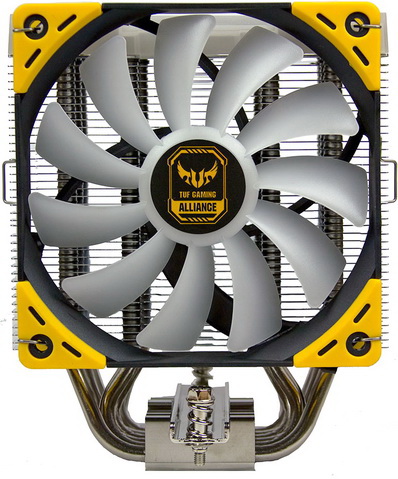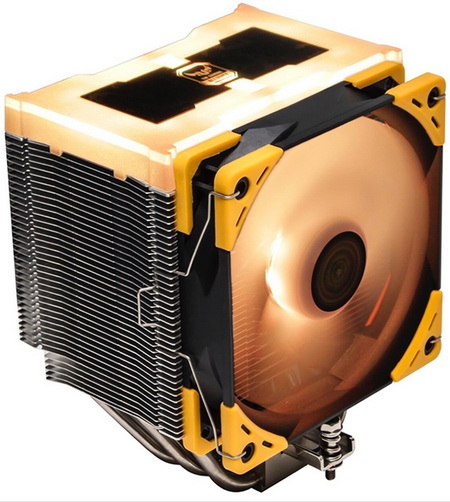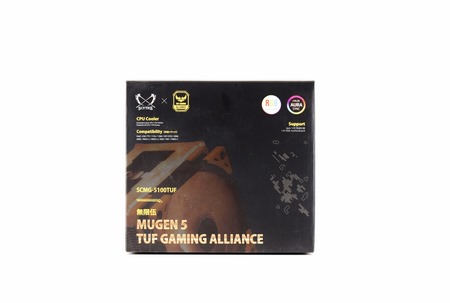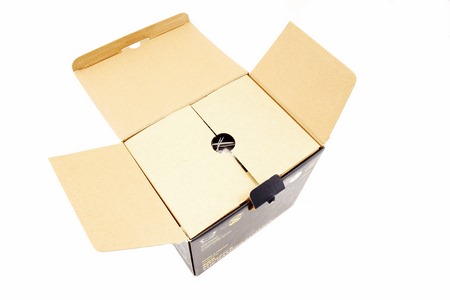INTRODUCTION

Catering to the "needs" of the global gaming community has always been beneficial to manufacturers and so naturally it's something we see all the time in this industry. Still it was quite a surprise to everyone when numerous manufacturers came together (namely ASUS, Antec, Apacer, Crucial, Cooler Master, Corsair, Deepcool, Enermax, G.Skill, GeIL, ID-COOLING, In Win, Scythe, SilverStone, T-FORCE and XPG) to create the TUF Gaming Alliance with one simple goal, to provide gamers with high performance hardware components. That's also why Scythe launched the Mugen 5 TUF Gaming Alliance model last year and since some of you asked, we decided to check it out.
Scythe Co., Ltd., (Registered and incorporated in Tokyo Japan) originally started its business operation in Japan's famous "Akihabara Electric Town" located in the metropolitan Tokyo, where visitors can find a variety of products from the latest computer parts to the world's most advanced high-tech electric devices. Scythe Co., Ltd., began its operation and business since November, 2002 as a distributor and the manufacturer of passive and low-noise PC parts. Since then, the company has established the R&D facility in Taiwan & China for production and quality control, and the USA office (in Los Angeles, California) & European office (in Hamburg, Germany) for customer care and sales support. At Scythe, we believe that the best ideas for product come simply from knowing customers' needs and their expectations. Based on this philosophy, the PC enthusiasts working at Scythe know what to develop because that is exactly what we would like to have for ourselves too! We offer products with 100% quality assurance and total pride, and if the product has the Scythe name on it, you can rest assure that its quality will be up to the "Zero Tolerance" standards!
Even though the Mugen 5 TUF model was released last year and thus long before the recent Mugen 5 Black RGB it's actually slightly larger (157.5x136x110.5mm - 154.5x136x110mm / fans included) and heavier (950g - 890g) something which i personally didn't expect (i thought they'd be identical in size and weight). There's another difference however so although both feature the same Kaze Flex 120 RGB PWM fan (1200RPM/51.17CFM/1.05mmH2O/24.9dBA - compatible with mainboard RGB sync technologies such as ASUS Aura Sync, ASRock Polychrome Sync, MSI Mystic Light and the GIGABYTE RGB Fusion 2.0) the Mugen 5 TUF also features an RGB illuminated top section (which is why it's also taller) which can sync with the fan to produce an rather impressive result. Cooling efficiency however is what matters so let's move forward with today’s review and see just how good the Mugen 5 TUF Gaming Alliance CPU cooler by Scythe really is.
SPECIFICATIONS AND FEATURES

PACKAGING AND CONTENTS
The TUF Gaming Alliance has black and yellow as its color so that's also what Scythe chose for their box (a partial product picture is placed at the front and is surrounded by the main product features).
On the right side we see the product specifications printed in 6 languages.
The bundle is placed inside a cardboard box as seen above.
The bundle includes the Mugen 5 TUF heatsink, Kaze Flex 120 RGB fan, 4 fan clips (you can use a 2nd fan in push & pull), Philips screwdriver, thermal paste tube, installation guide, backplate and all the necessary screws, standoffs and brackets to mount the cooler onto Intel LGA 775/1150/1151/1155/1156/1366/2011/2011-3/2066 and AMD AM2/AM2+/AM3/AM3+/AM4/FM1/FM2/FM2+ mainboards.
THE MUGEN 5 TUF GAMING ALLIANCE
As mentioned earlier the Mugen 5 TUF Gaming Alliance model features an 157.5mm tall, 83.5mm long and 130mm wide heatsink.
Scythe chose the same path as with the ARGB model so they've placed an RGB illuminated plastic cover at the top (the two holes at the top can be used with the bundled screwdriver to mount the cooler onto your mainboard).
Just like the other three Mugen 5 models to arrive in the lab the heatsink of the TUF model is also made out of 39 aluminum fins.
The asymmetric design of the heatsink not only allows for easier installation but also ensures zero clearance issues with both mainboard components and memory modules.
As usual the Mugen 5 TUF features a total of six 6mm nickel-plated copper heatpipes.
The large copper base features a mirror like finish (nickel plated) as you can see from the above picture.
Scythe has once again used their brand new Kaze Flex 120 RGB PWM fan (this time with yellow rubber pads however on all 4 corners) which can spin up to 1200RPM to produce up to 51.17CFM of airflow and 1.05mmH2O if static pressure with just 24.9dBA of noise.
With the Kaze Flex 120 RGB PWM fan installed the Mugen 5 TUF Gaming Alliance model measures 110.5mm in length and weighs 950g.
TEST BED


TESTING METHODOLOGY
We always take things quite seriously when it comes to work so just like with the previous LGA1366 database we will not be testing each CPU Cooler on its own and with different ambient temperature levels and thus we can actually have yet another valid CPU Cooler database. Testing a CPU Cooler automatically means that you need to know where it stands against the immediate competition and to accomplish that we have spent both money and time through the years, something that we plan to continue to do so in order to get the most accurate results for the end consumers who read these lines. Every CPU cooler in this database is tested with the bundled 140mm/120mm/92mm/80mm fans while working at both idle speed and 100% of their speeds for all the temperature tests. CPU Coolers that do not come bundled with a fan/s are measured using a Noctua fan (size dependent on the model) to test for the temperature tests but due to the lack of a stock fan dBA level tests are obviously skipped. Single (120/140mm) watercooling solutions are tested with the radiator mounted at the rear of our test rig while dual/triple/quad (240/260/280/360/420/480/560mm) solutions with the radiator mounted at the top. For the dBA tests every cooler in the database was measured both while on idle mode or with the fan controller in the minimum setting and while on extreme load or with the fan controller all the way to the highest possible setting (PWM fans do that on their own without our intervention). Every single test takes place in a temperature controlled room of 23 degrees Celsius Ambient Temp with the help of two AC units placed diagonally inside the room. The Arctic Silver 5 thermal paste is used with every CPU Cooler in our latest LGA2011 database (although initially this was not the plan, we had to change things to get the most accurate results). Finally, it's very important to point out that just because a CPU Cooler is better than another when tested with our test rig that does not necessarily mean that the same performance differences will apply 100% for other CPU models and in other situations (such as different ambient temps and system configurations).
To successfully record the load temperatures, we use the latest OCCT application for around 6-10 minutes to push the processor to its limits and after that is done and the temperatures are recorded, we wait for about 10-20 minutes for the CPU to cool down and record the idle temperatures. This is done to allow time for the thermal conductive material to achieve the optimal performance level. Same procedure is then repeated with the Passmark BurnIn Test as a failsafe just in case the OCCT results are wrong. This procedure is more time consuming than the usual peltier/thermometer tests but this way not only can we deliver real world results to our readers based on real CPUs but we can also triple check the results using a variety of programs. Last but not least the temperatures were recorded using both the latest versions of AIDA64 and RealTemp while the noise level tests are performed using a high precision ExTech HD600 Decibel Meter placed about 10-15cm above the CPU Cooler. Still although the same testing procedure applies to all units do take into consideration that unlike the official numbers which are measured in special noise isolated labs with just the fans here, we also have both the rest of the cooler and the rest of the system (although all system fans are turned off when recording noise levels).
TEST RESULTS


CONCLUSION

The sole difference between the Mugen 5 TUF and the Mugen 5 Black RGB is the TUF theme which includes both the top RGB illuminated plastic cover and the yellow rubber pads of the Kaze Flex 120 RGB PWM fan (ah, also the sticker at the front). Because of that I didn’t really expect anything different in cooling efficiency and noise levels as with the Black RGB model and as you can all tell from the charts the largest deviation was in the noise department something which is actually totally normal (that’s also why manufacturers always put the +-10% besides the RPM of their fans – two fans are never quite identical). In terms of design well it all comes down to whether or not you like the TUF Gaming Alliance color theme or not (even if you don’t however this is an RGB model so it doesn’t matter that much).
Right now, the Scythe Mugen 5 TUF Gaming Alliance CPU cooler retails for 76.32Euros inside the USA (Amazon.com) and for 54.90Euros inside the EU (Amazon.de) a price tag which at least on this side is well balanced. Overall, I’m very pleased with the Mugen 5 TUF, granted it’s far from the highest performance CPU cooler in the market today but it does very well, looks great, noise levels are low and it’s a great choice for gamers looking to build a TUF system (I’ll be showcasing one in the following days) and that’s why our Golden Award is well justified.

PROS
- Build Quality
- Good Performance
- TUF Design / Colors
- RGB Lighting (Mainboard Adjusted)
- Zero Clearance Issues with Most Mainboards
- Easy Installation (H.P.M.S III)
- Dual Fan Solution
CONS
- Size (For Some)
- Color Theme (TUF Fans)

 O-Sense
O-Sense



















.png)

